The New Deal
In March 1932, Franklin D. Roosevelt asked Raymond Moley, a professor of public law at Columbia University, "to pull together some intellectuals who might help Roosevelt's bid for the presidency". Moley recruited two of his university colleagues, Rexford G. Tugwell and Adolf Berle. Others who joined the group, later known as the Brains Trust, included Roosevelt's law-partner, Basil O'Connor and his main speech writer, Samuel Rosenman. Others who attended these meetings included Felix Frankfurter, Louis Brandeis (who introduced the group to the ideas of John Maynard Keynes) and Benjamin Cohen. (1)
It has been argued by Patrick Renshaw, the author of Franklin D. Roosevelt (2004): "Politically, Tugwell was on the left with Berle on the right. Moley chaired regular meetings of the brains trust, which Samuel Rosenman and Basil O'Connor also attended. FDR was not an intellectual, but enjoyed their company and was in his element at the free-wheeling discussions which hammered out the New Deal." (2)
However, all the men shared the philosophy advocated by John Dewey that "organized social intelligence should shape society". They were all impressed by the work of women such as Jane Addams, Ellen Starr, Florence Kelley, Alzina Stevens, Julia Lathrop, Mary Kenney, Mary McDowell, Mary Ovington, Alice Hamilton, Belle La Follette, Fanny Garrison Villard, Emily Balch, Jeanette Rankin, Lillian Wald, Edith Abbott, Grace Abbott, Mary Heaton Vorse, Charlotte Perkins Gilman, Crystal Eastman and Sophonisba Breckinridge, that had been so involved in the social reform movement. (3)
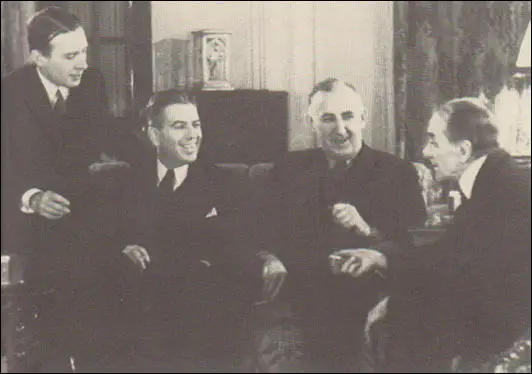
Rexford G. Tugwell and Adolf Berle argued the free market of Adam Smith had vanished forever. They concluded that the market no longer performed its classic function of maintaining an equilibrium between supply and that the two thousand men who controlled American economic life, manipulated prices and production. Tugwell wrote: "The cat is out of the bag. There is no invisible hand. There never was... We must now supply a real and visible guiding hand to do the task which that mythical, nonexistent, invisible agency was supposed to perform, but never did." (4)
In a speech jointly written by Franklin D. Roosevelt, Raymond Moley and Samuel Rosenman, he gave a speech on 7th April 1932 where he attacked the administration of President Herbert Hoover for attacking the symptoms of the Great Depression, not the cause. "It has sought temporary relief from the top down rather than permanent relief from the bottom up. These unhappy times call for the building of plans that put their faith once more in the forgotten man at the bottom of the economic pyramid." (5)
Roosevelt was selected as the Democratic Party candidate for the 1932 Presidential Election to fight President Herbert Hoover. In his acceptance speech Roosevelt argued: "Yes, the people of this country want a genuine choice this year, not a choice between two names for the same reactionary doctrine. Ours must be a party of liberal thought, of planned action, of enlightened international outlook, and of the greatest good to the greatest number of our citizens.... Let us all here assembled constitute ourselves prophets of a new order of competence and of courage. This is more than a political campaign; it is a call to arms. Give me your help, not to win votes alone, but to win in this crusade to restore America to its own people." He then added the words: "I pledge you, I pledge myself, to a New Deal for the American people." (6)
In the election Roosevelt received 22,825,016 votes to Hoover's 15,758,397. With a 472-59 margin in the Electoral College, he captured every state south and west of Pennsylvania. Roosevelt carried more counties than a presidential candidate had ever won before, including 282 that had never gone Democratic. Of the forty states in Hoover's victory coalition four years before, the President held but six. Hoover received 6 million fewer votes than he had in 1928. The Democrats gained ninety seats in the House of Representatives to give them a large majority (310-117) and won control of the Senate (60-36). Only one previous Republican candidate, William Howard Taft, had done as badly as Hoover. (7)
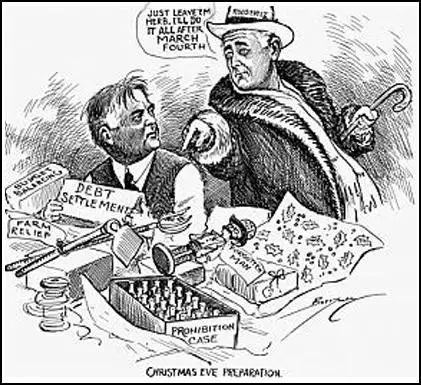
all after March 4th." Cliff Berryman, Washington Evening Star (December, 1932)
Franklin D. Roosevelt was elected on 8th November, 1932, but the inauguration was not until 4th March, 1933. While he waited to take power, the economic situation became worse. Three years of depression had cut national income in half. Five thousand bank failures had wiped out 9 million savings accounts. By the end of 1932, 15 million workers, one out of every three, had lost their jobs. When the Soviet Union's trade office in New York issued a call for 6,000 skilled workers to go to Russia, more than 100,000 applied. (8)
The Banking Crisis
President Franklin D. Roosevelt took office on 4th March, 1933. His first act as president was to deal with the country's banking crisis. Since the beginning of the depression, a fifth of all banks had been forced to close. Already 389 banks had shut their doors since the beginning of the year. As a consequence, around 15% of people's life-savings had been lost. Banking was at the point of collapse. In 47 of the 48 states banks were either closed or working under tight restrictions. To buy time to seek a solution Roosevelt declared a four-day bank holiday. It has been claimed that the term "bank holiday" was used to seem festive and liberating. "The real point - the account holders could not use their money or get credit - was obscured." (9)
Roosevelt's advisers, Louis Brandeis, Felix Frankfurter, and Rexford G. Tugwell agreed with progressives who wanted to use this opportunity to establish a truly national banking system. Heads of great financial institutions opposed this idea. Louis Howe supported conservatives on the Brains Trust such as Raymond Moley and Adolf Berle, who feared such a measure would create very dangerous enemies. Roosevelt was worried that such action "might accentuate the national sense of panic and bewilderment". (10)
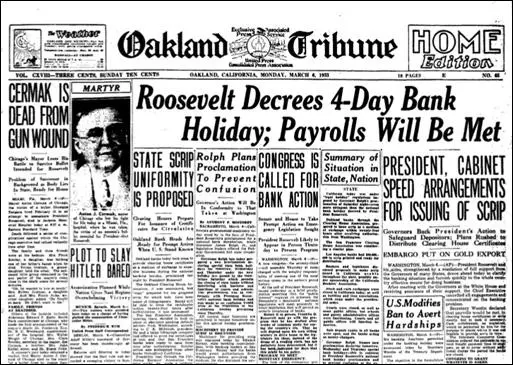
Roosevelt summoned Congress into special session and presented it with an emergency banking bill that permitted the government to reopen the banks it ascertained to be sound, and other such banks as rapidly, as possible." The statue passed the House of Representatives by acclamation in a voice vote in forty minutes. In the Senate there was some debate and seven progressives, Robert LaFollette Jr, Huey P. Long, Gerald Nye, Edward Costigan, Henrik Shipstead, Porter Dale and Robert Davis Carey, voted against as they believed that it did not go far enough in asserting federal control. (11)
On 9th March, 1933, Congress passed the Emergency Banking Relief Act. Within three days, 5,000 banks had been given permission to be re-opened. President Roosevelt gave the first of his radio broadcasts (later known as his "fireside chats"). It is estimated that it had an audience of 60 million people: "Some of our bankers have shown themselves either incompetent or dishonest in their handling of the people's funds. They had used money entrusted to them in speculations and unwise loans. This was, of course, not true of the vast majority of our banks, but it was true in enough of them to shock the people for a time into a sense of insecurity. It was the government's job to straighten out this situation and do it as quickly as possible. And the job is being performed. Confidence and courage are the essentials in our plan. We must have faith; you must not be stampeded by rumours. We have provided the machinery to restore our financial system; it is up to you to support and make it work. Together we cannot fail." (12)
Will Rogers welcomed the speech: "Mr. Roosevelt stepped to the microphone last night and knocked another home run. His message was not only a great comfort to the people, but it pointed a lesson to all radio announcers and public speakers what to do with a big vocabulary - leave it at home in the dictionary. Our President took such a dry subject as banking (and when I say dry, I mean dry, for if it had been liquid, he wouldn't have to speak on it at all) and made everybody understand it, even the bankers." (13)
Agricultural Adjustment Act
In September 1922, the Fordney-McCumber Act was signed by President Warren Harding. These raised tariffs to levels higher than any previously in American history in an attempt to bolster the post-war economy, protect new war industries, and aid farmers. Over the next eight years it raised the American ad valorem tariff rate to an average of about 38.5% for dutiable imports and an average of 14% overall. It has been claimed that the tariff was defensive, rather than offensive. (14)
Most of American trading partners had raised their own tariffs to counter-act this measure. The Democratic Party that had opposed tariffs argued that it was to blame for the agricultural depression that took place during the 1920s. Senator David Walsh pointed out that farmers were net exporters and so did not need protection. He explained that American farmers depended on foreign markets to sell their surplus. The price of farming machinery also increased. For example, the average cost of a harness rose from $46 in 1918 to $75 in 1926, the 14-inch plow rose from $14 to $28, mowing machines rose from $45 to $95, and farm wagons rose from $85 to $150. Statistics of the Bureau of Research of the American Farm Bureau that showed farmers had lost more than $300 million annually as a result of the tariff. (15)
Although agriculture sector had problems during the 1920s, American industry prospered. The real wages of industrial workers increased by about 10 per cent during this period. However, productivity rose by more than 40%. The farming community did not enjoy the benefits of this growing economy. As Patrick Renshaw has pointed out: "The real problem was that in both agricultural and industrial sectors of the economy America's capacity to produce was tending to outstrip its capacity to consume." (16)
Herbert Hoover and the Republicans believed the Forder-McCumber tariffs had helped the American economy to grow. William Borah, the charismatic senator from Idaho, widely regarded as a true champion of the American farmer, had a meeting with Hoover and offered to give him his full support if he promised to increase tariffs of agricultural products if elected. (17) Hoover agreed with the proposal and during the campaign promised the American electorate that he would increase the tariff. (18)
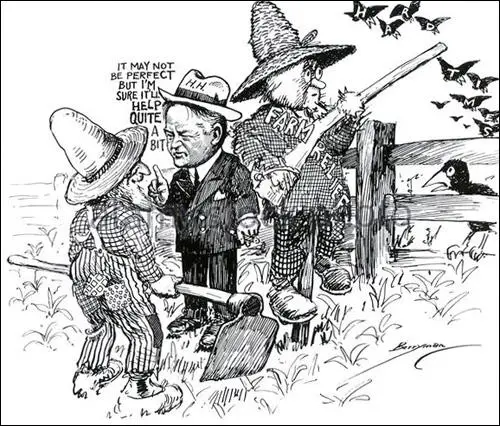
After his election Hoover asked Congress for an increase of tariff rates for agricultural goods. The Smoot-Hawley Act was passed in the Senate on a vote of 44 to 42, with 39 Republicans and 5 Democrats voting in favor of the bill. Hoover signed the bill on 17th June, 1930. The Economist Magazine argued that the passing of the Smoot–Hawley Tariff Act was "the tragic-comic finale to one of the most amazing chapters in world tariff history… one that Protectionist enthusiasts the world over would do well to study.” (19)
By 1933 agriculture in America was in a terrible state. For example, per capita farm income was one quarter that of non-farmworkers. Farm prices fell by 53 per cent from 1929 to 1932. Net farm income was down by 70 per cent. "A cow that sold for $83 in 1929 now brought $28. Cotton sold for six cents a pound. Corn in Nebraska brought thirty-one cents a bushel, Kansas wheat thirty-eight cents. By early 1933, 45 per cent of all farm mortgages were delinquent and facing foreclosure." (20)
Harry Terrell was brought up on a farm in South Carolina: "320 acres of farm land, fine land, that my uncle owned and cleared, he lost it because they foreclosed the mortgage. Some of the best in the state, and he couldn't borrow a dime. The farmers didn't have anything they could borrow on...Corn was going for eight cents a bushel. One county insisted on burning corn to heat the courthouse because it was cheaper than coal... The county was getting up in arms about taking a man's property away from him. It was his livelihood. When you took a man's horses and his plow away, you denied him food, you just convicted his family to starvation." (21)
Oscar Heline was someone who was forced into bankrupcy by the Great Depression: "First, they'd take your farm, then they took your livestock, then your farm machinery. Even your household goods. And they'd move you off... In South Dakota, the county elevator listed corn as minus three cents. Minus three cents a bushel. If you wanted to sell 'em a bushel of corn, you had to bring in three cents. They couldn't afford to handle it." (22)
Henry A. Wallace was appointed as Secretary of Agriculture. Rexford G. Tugwell, became assistant secretary. Tugwell wrote that "Since my graduate-school days, I have always been able to excite myself more about the wrongs of farmers than those of urban workers." (23) Together they drafted what became known as the Agricultural Adjustment Act. The plan was to raise farm income by reducing agricultural surpluses through a system of domestic allotments. Farmers would be paid directly by the government not to produce crops beyond an allotment set by the secretary of agriculture. The proposal aimed to deal with the crucial problem of depressed prices and mounting surpluses. (24)
Calvin Benham Baldwin was one of those employed by Wallace to help solve these problems. "The Agricultural Adjustment Administration (AAA) came into being shortly after I got to Washington. Its purpose was to increase farm prices, which were pitifully low. All the farmers were in trouble, even the big ones. Hog prices had just gone to hell. They were four, five cents a pound? The farmers were starving to death. It was decided to slaughter piggy sows (a pregnant pig). The AAA decided to pay the farmers to kill them and the little pigs. Lot of them went into fertilizer. You had a similar situation on cotton. Prices were down to four cents a pound and the cost of producing was probably ten. So a program was initiated to plow up cotton. A third of the crop, if I remember. Cotton prices went up to ten cents, maybe eleven." (25)
On 16th March, 1933, President Roosevelt sent the first genuine New Deal measure to Congress. It was a radical departure, suggesting government control of agricultural production, historically the most individualitic segment of the economy. Roosevelt admitted that the Agricultural Adjustment Act was a great departure from previous legislation: "I tell frankly that it is a new and untried path, but I tell you with equal frankness that an unprecedented condition calls for the trial of new means to rescue agriculture." (26)
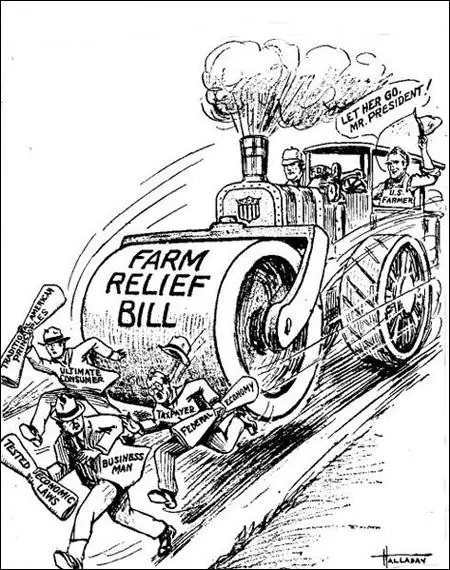
The House of Representatives passed the Agricultural Adjustment Act without any amendments, but the Senate was not so convinced. The measure shocked conservatives and upset those who had to pay the proposed processing tax. Joseph W. Martin of Massachusetts claimed that it the bill passed it would "put America on the road to Moscow". Frank Freidel, the author of Franklin D. Roosevelt: A Rendezvous with Destiny (1990) pointed out that "others plastered a red label on Roosevelt's agricultural experts, or denounced them as professors who had no knowledge of farm realities." (27)
At the same time, some radicals, such as Burton Wheeler and Lynn Frazier, argued that the farmer deserved nothing less that government guarantee of his "cost of production". Tugwell observed: "For real radicals such as Wheeler, Frazier, etc., it is not enough; for conservatives it is too much; for Jefferson Democrats it is a new control which they distrust. For the economic philosophy which it represents there are no defenders at all. Nevertheless, in spite of everything, it will probably become law." It was passed on 10th May, 1933. (28)
Most farmers were very pleased by the passing of the Agricultural Adjustment Act. Harry Terrell claims: "Henry Wallace and his granary was the man who saved the farmer... They took this corn and paid for it and stored it. They put a price on it that was above the miserable going price." (29) Oscar Heline agrees "It was Wallace who saved us, put us back on our feet. He understood our problems." Heline was in a group of farmers who went to see Henry A. Wallace: "He made it clear to us he didn't want to write the law. He wanted the farmers themselves to write it... He would always give his counsel, but he never directed us. The program came from the farmers themselves." (30)
The Farm Credit Administration was established on 27th March, 1933. It was a merger of government farm loan agencies under the control of Henry Morgenthau. On 16th June, 1933, Congress passed the Farm Credit Act, attempted to deal with the problem of farm mortgages. Over the next eighteen months it would refinance a fifth of all farm mortgages. (31)
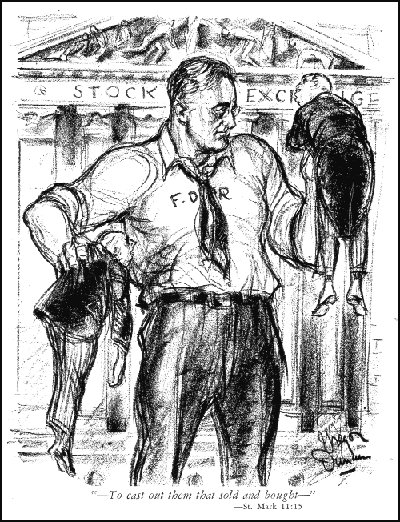
Gregor Duncan, Life Magazine (May, 1934)
Roosevelt later recalled that the establishment of the Farm Credit Administration was a great success as they needed to action to prevent people losing their farms. "We saved farms from foreclosure through the Home Owners' Loan Corporation and the Farm Credit Administration. I suppose some people today would like to repeal all that and go back to the conditions of 1932, when the people out West mobbed a Federal Judge because he was trying to carry out the existing law of the land in foreclosing a farm." (32)
Roosevelt attempted to placate conservatives by appointing George N. Peek as head of the Agricultural Adjustment Administration (AAA). He also appointed Jerome Frank as general council to the AAA. Peek clashed with both Wallace and Frank. John C. Culver and John C. Hyde, the authors of American Dreamer: A Life of Henry A. Wallace (2001) have argued that Peek never liked Jerome Frank and wanted to appoint his own general council: "Crusty and dogmatic, Peek still seethed with resentment over Wallace's appointment as secretary, a position he coveted.. Frank was liberal, brash, and Jewish. Peek loathed everything about him. In addition, Frank surrounded himself with idealistic left-wing lawyers... whom Peek also despised." This group of left-wing idealists included Frederic C. Howe, Adlai Stevenson, Alger Hiss, Lee Pressman, Hope Hale Davis and Gardner Jackson. Peek later wrote that the "place was crawling with... fanatic-like... socialists and internationalists." On another occasion he called the men "Lenin chicks". (33)
The conflict between Peek and the young liberals in the AAA continued. Peek's main objective was to raise agricultural prices through cooperation with processors and large agribusinesses. Other members of the Agricultural Department such as Jerome Frank were primarily concerned to promote social justice for small farmers and consumers. On 15th November, 1933, Peek demanded that Wallace should fire Frank for insubordination. Wallace, who agreed more with Frank than Peek, refused. Peek was also hostile to Rexford Tugwell, who believed that Peek was an anti-Semite." (34)
Peek resigned from the AAA on 11th December, 1933. Peek was replaced by Chester R. Davis. He also came into conflict with these young radicals. In February 1935, Davis insisted that Jerome Frank and Alger Hiss should be dismissed. Wallace was unable to protect them: "I had no doubt that Frank and Hiss were animated by the highest motives, but their lack of agricultural background exposed them to the danger of going to absurd lengths... I was convinced that from a legal point of view they had nothing to stand on and that they allowed their social preconceptions to lead them to something which was not only indefensible from a practical, agricultural point of view, but also bad law." (35)
Davis told Frank: "I've had a chance to watch you and I think you are an outright revolutionary, whether you realize it or not". Wallace wrote in his diary: "I indicated that I believed Frank and Hiss had been loyal to me at all times, but it was necessary to clear up an administrative situation and that I agreed with Davis". According to Sidney Baldwin, the author of Poverty and Politics: The Rise and Decline of the Farm Security Administration (1968), Wallace greeted Frank with tears in his eyes: "Jerome, you've been the best fighter I've had for my ideas, but I've had to fire you... The farm people are just too strong." (36)
Rexford Tugwell attempted to protect Frank and Hiss and received support from Louis Howe and Harry Hopkins: "I went and talked to Harry Hopkins who was outraged, to Louis Howe who was sympathetic, to Henry Wallace who was red-faced and ashamed, and to the President. My first impulse was to resign... I made up my mind that Jerome must have justice." (37) Roosevelt refused to let him go and agreed to appoint Frank as a special counsel to the Reconstruction Finance Association. (38)
Civilian Conservation Corps
After he was elected President Franklin D. Roosevelt initially opposed massive public works spending. However, by the spring of 1933, the needs of more than fifteen million unemployed had overwhelmed the resources of local governments. In some areas, as many as 90 per cent of the people were on relief and it was clear something needed to be done. His close advisors and colleagues, Harry Hopkins, Rexford Tugwell, Robert LaFollette Jr. Robert Wagner, Fiorello LaGuardia, George Norris and Edward Costigan eventually won him over. (39)
Frances Perkins explained in her book, The Roosevelt I Knew (1946): In one of my conversations with the President in March 1933, he brought up the idea that became the Civilian Conservation Corps. Roosevelt loved trees and hated to see them cut and not replaced. It was natural for him to wish to put large numbers of the unemployed to repairing such devastation. His enthusiasm for this project, which was really all his own, led him to some exaggeration of what could be accomplished. He saw it big. He thought any man or boy would rejoice to leave the city and work in the woods. It was characteristic of him that he conceived the project, boldly rushed it through, and happily left it to others to worry about the details." (40)
On 21st March, 1933, sent an unemployment relief message to Congress. It took only eight days to create the Civilian Conservation Corps. It authorized half a billion dollars in direct federal grants to the states for relief. The CCC was a program designed to tackle the problem of unemployed young men aged between 18 and 25 years old. By September, 1935, over five hundred thousand young men lived in CCC camps. (41)
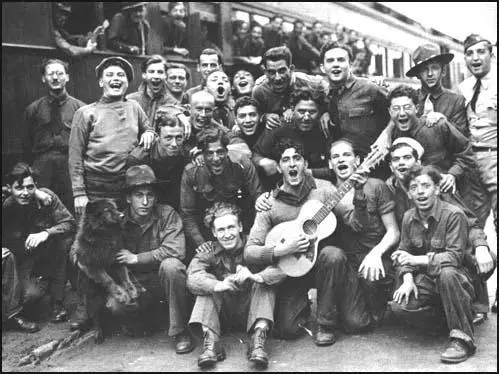
The Civilian Conservation Corps camps were set up all over the United States. Blackie Gold told Studs Terkel: "I was at CCC's for six months, I came home for fifteen days, looked around for work, and I couldn't make $30 a month, so I enlisted back in the CCC's and went to Michigan. I spent another six months there planting trees and building forests. And came out. But still no money to be made. So back in the CCC's again. From there I went to Boise, Idaho, and was attached to the forest rangers. Spent four and a half hours fighting forest fires." (42)
The organisation was based on the armed forces with officers in charge of the men. Over 25,000 men were First World War veterans. The pay was $30 dollars a month with $22 dollars of it being sent home to dependents. The men planted three billion trees, built public parks, drained swamps to fight malaria, built a million miles of roads and forest trails, restocked rivers with nearly a billion fish, worked on flood control projects and a range of other work that helped to conserve the environment. Between 1933 and 1941 over 3,000,000 men served in the CCC. (43)
National Revovery Administration
Marriner Eccles, an advocate of the economic ideas of John Maynard Keynes and Lauchlin Currie, worked at the Treasury Department under the treasury secretary Henry Morgenthau. Eccles went before the Senate Finance Committee in 1933. According to Patrick Renshaw, the author of Franklin D. Roosevelt (2004): "Though the young Mormon banker from Utah claimed never to have read Keynes he had nevertheless jolted Senate finance committee hearings in 1933 by urging that the federal government forget about trying to balance budgets during the depression and instead spend heavily on relief, public works, the domestic allotment plan and refinancing farm mortgages, while cancelling what remained of war debt." (43a)
The National Industrial Recovery Act (NIRA) was passed by the Senate on 13th June by a vote of 46 to 37. The National Recovery Administration (NRA) was set up to enforce the NIRA. President Franklin D. Roosevelt named Hugh S. Johnson to head it. Roosevelt found Johnson's energy and enthusiasm irresistible and was impressed with his knowledge of industry and business. William E. Leuchtenburg has commented: "A gruff, pugnacious martinet with the leathery face and order-barking rasp of a former cavalry officer, Johnson had no illusions about the dimensions of the job." (44)
Huey P. Long was totally opposed to the appointment. He argued that Johnson was nothing more than an employee of Bernard Baruch and would permit the most conservative elements in the Democratic Party to do as they pleased with American industry. Guy Tugwell also had his concerns about his relationship with Baruch: "It would have been better if he had been further from Baruch's special influence." He was concerned about other matters: "I think his tendency to be gruff in personal matters will be an handicap and his occasional drunken sprees will not help." However, overall he thought it was a good appointment: "Hugh is sincere, honest, believes in many social changes which seem to me right, and will do a good job." Surprisingly, Baruch himself had warned Frances Perkins against the appointment: "Hugh isn't fit to be head of the NRA. He's been my number-three man for years. I think he's a good number-three man, maybe a number-two man, but he's not a number-one man. He's dangerous and unstable. He gets nervous and sometimes goes away without notice. I'm fond of him, but do tell the President to be careful. Hugh needs a firm hand." (45)
Johnson expected to run the whole of the NRA. However, Roosevelt decided to split it into two and placed the Public Works Administration (PWA) with its 3.3 billion dollar public works programme, under the control of Harold Ickes. When he heard the news Johnson stormed out of the cabinet meeting. Roosevelt sent Frances Perkins after him and she eventually persuaded him not to resign.As David M. Kennedy has pointed out in Freedom from Fear (1999), the NRA and the PWA "were to be like two lungs, each necessary for breathing life into the moribund industrial sector". (46)
Jean Edward Smith, the author of FDR (2007): "No two appointees could have been more dissimilar, and no two less likely to cooperate. For Johnson, an old cavalryman, every undertaking was a hell-for-leather charge into the face of the enemy. Ickes, on the other hand, was pathologically prudent. As he saw it, the problem of the public works program was not to spend money quickly but to spend it wisely. Obsessively tightfisted, personally examining every project in minute detail, Ickes spent a minuscule $110 million of PWA money in 1933." (47)
The National Recovery Act allowed industry to write its own codes of fair competition but at the same time provided special safeguards for labor. Section 7a of NIRA stipulated that workers should have the right to organize and bargain collectively through representatives of their own choosing and that no one should be banned from joining an independent union. The NIRA also stated that employers must comply with maximum hours, minimum pay and other conditions approved by the government. Johnson asked Roosevelt if Donald R. Richberg could be general counsel of the NRA. Roosevelt agreed and on 20th June, 1933, Roosevelt appointed him to the post. Richberg's main task was to implement and defend Section 7(a) of the NIRA. (48)
Employers ratified these codes with the slogan "We Do Our Part", displayed under a Blue Eagle at huge publicity parades across the country, Franklin D. Roosevelt used this propaganda cleverly to sell the New Deal to the public. At a Blue Eagle parade in New York City a quarter of a million people marched down Fifth Avenue. Roosevelt argued that "there is a unity in this country which I have not seen and you have not seen since April, 1917." (49)
Charles Edison told his workers: "President Roosevelt has done his part: now you do something. Buy something - buy anything, anywhere; paint your kitchen, send a telegram, give a party, get a car, pay a bill, rent a flat, fix your roof, get a haircut, see a show, build a house, take a trip, sing a song, get married. It does not matter what you do - but get going and keep going. This old world is starting to move." (49a)
The NRA program was voluntary. However, those businessmen who accepted the codes developed by the various trade associations, could place the NRA blue eagle symbol in their windows and on the packaging of their goods. This virtually made the scheme compulsory as those companies that did not display the NRA symbol were seen as unpatriotic and selfish. (50)
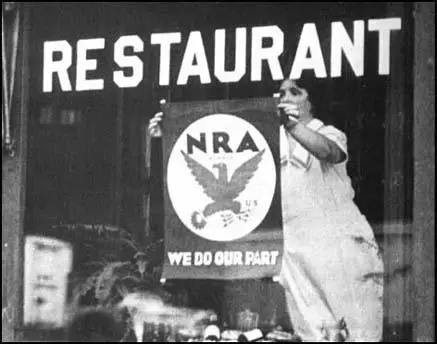
Johnson's first success was with the textile industry. This included bringing an end to child labour. As William E. Leuchtenburg, the author of Franklin D. Roosevelt and the New Deal (1963), has pointed out: "At the dramatic cotton-code hearing, the room burst into cheers when textile magnates announced their intention to abolish child labor in the mills. In addition, the cotton textile code stipulated maximum hours, minimum wages, and collective bargaining." As Johnson pointed out: "The Textile Code had done in a few minutes what neither law nor constitutional amendment had been able to do in forty years." (51)
On 30th June, 1933, Hugh S. Johnson commented: "You men of the textile industry have done a very remarkable thing. Never in economic history have labor, industry, government and consumers' representatives sat together in the presence of the public to work out by mutual agreement a 'law merchant' for an entire industry... The textile industry is to be congratulated on its courage and spirit in being first to assume this patriotic duty and on the generosity of its proposals." However, some trade unionists criticized the agreement to a $11 minimum wage as a "bare subsistence wage" that would provide workers with little more than "an animal existence." (52)
By the end of July 1933 Johnson had half the main ten industries, textiles, shipbuilding, woolens, electricals and the garment industry, signed up. This was followed by the oil industry but he was forced to make a raft of concessions on price policy to persuade the steel industry to join. On 27th August, the automobile manufactures, except for Henry Ford, agreed terms with Johnson. When the coal operators fell in line on 18th September, Johnson had won the last of the big ten industries to the NRA in a period of only three months. (53)
The coal code brought dramatic gains for miners. It included the right of miners to a checkweighman and payment on a net-ton basis and prohibitions against child labour, compulsory scrip wages and the compulsory company store. It also meant higher wages. As a result of the agreement, the United Mine Workers increased union membership from 100,000 to 300,000.
Ford announced he intended to meet the wage and hour provision of the code or even to improve on them. However, he refused to sign up to the code. Johnson reacted by urging the public not to purchase Ford vehicles. He also told the federal government not to purchase vehicles from Ford dealers. Johnson commented: "If we weaken on this, it will greatly harm the Blue Eagle principle and campaign." Johnson's actions resulted in a decline in sales of Ford cars and trucks in 1933. However, it only had a short-term impact and in 1934 the company had increased sales and profits. (54)
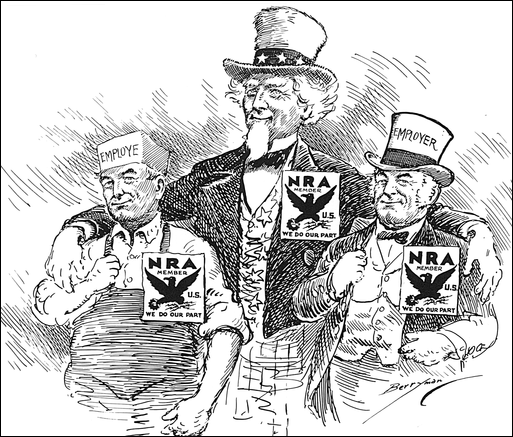
John Kennedy Ohl has argued that during the summer of 1933 Johnson was called the "busiest man" in the United States: "Whether sitting at the desk in the Commerce Department or on the platform in the auditorium, Johnson, with his coat off, shirt open at the neck, sleeves rolled up, and perspiration streaming down his cheek... He chain-smoked Old Gold cigarettes, often lighting up one while two others were still burning in a nearby ashtray. Between visitors, sometimes over a hundred a day, and telephone calls, he scanned official documents and hurriedly scribbled his signature on letters brought in by his secretary." (55)
Some critics described Johnson as behaving like a fascist. John T. Flynn argued: "He (Johnson) began with a blanket code which every business man was summoned to sign to pay minimum wages and observe the maximum hours of work, to abolish child labor, abjure price increases and put people to work. Every instrument of human exhortation opened fire on business to comply the press, pulpit, radio, movies. Bands played, men paraded, trucks toured the streets blaring the message through megaphones. Johnson hatched out an amazing bird called the Blue Eagle. Every business concern that signed up got a Blue Eagle, which was the badge of compliance.... The NRA provided that in America each industry should be organized into a federally supervised trade association. It was not called a corporative. It was called a Code Authority. But it was essentially the same thing. These code authorities could regulate production, quantities, qualities, prices, distribution methods, etc., under the supervision of the NRA. This was fascism." (56)
Social Security Act
Francis Townsend, a doctor, lost his job during the Great Depression and was forced into retirement. William E. Leuchtenburg, the author of Franklin D. Roosevelt and the New Deal (1963), has argued: "He was sixty-seven years old, and had less than a hundred dollars in savings. Disturbed not only by his own plight but by that of others like him - elderly people from Iowa and Kansas who had gone west in the 1920's and now faced the void of unemployment with slim resources." (57)
In 1933 Townsend proposed a scheme whereby the Federal government would provide every person over 60 a $200 monthly pension (roughly $2,600 in today's money), on condition that he or she retire from all gainful work and spent the money in the United States. Townsend claimed that his Old Age Revolving Pension Plan could be financed by a 2 per cent tax on business transactions. Townsend argued that his plan would help the economy as older people would be compelled to surrender their positions to the younger unemployed and the spending of the pension money would produce a demand for goods and services that would create still more jobs. (58)
Some critics described Townsend's plans as being an example of the ideas of the "crackpot Left". (59) Other observers pointed out that it was far from radical and appealed to Protestant rural America and proclaimed traditional values, and promised to preserve the profit system free from alien collectivism, socialism and communism. In the words of Townsend, the movement embraced people "who believe in the Bible, believe in God, cheer when the flag passes by, the Bible Belt solid Americans." He told his followers: "The movement is yours, my friends... Without you I am powerless but with you I can remake the world for mankind." (60)
Walter Lippmann observed: "If Dr. Townsend's medicine were a good remedy, the more people the country could find to support in idleness the better off it would be." Townsend replied "My plan is too simple to be comprehended by great minds like Mr. Lippmann's." (61) One historian has pointed out that "Townsend meetings featured frequent denunciations of cigarettes, lipstick, necking, and other signs of urban depravity. Townsendites claimed as one of the main virtues of the plan that it would put young people to work and stop them from spending their time in profligate pursuit of sex and liquor." (62)
Townsend plan would have diverted 40 per cent of the national income to 9 per cent of the people. It obtained a great deal of public support and by 1935 his Townsend Club had over 5 million members. Most of them from among otherwise conservative people, that politicians throughout the country had to take these ideas into consideration. The pressure increased when Townsend handed in to President Franklin D. Roosevelt a petition supporting the Old Age Revolving Pension Plan that had been signed by over 20 million people. (63)
Frances Perkins, one of Roosevelt's most senior colleagues, later recalled in her autobiography, The Roosevelt I Knew (1946): "One hardly realizes nowadays how strong was the sentiment in favour of the Townsend Plan and other exotic schemes for giving the aged a weekly income. In some districts the Townsend Plan was the chief political issue, and men supporting it were elected to Congress. The pressure from its advocates was intense." (64)
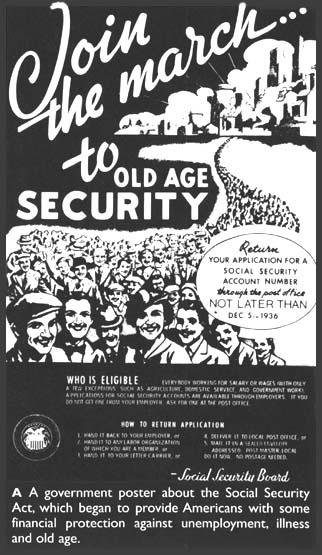
The measures taken by President Roosevelt did help 2 million people to find jobs by 1934 but unemployment remained high at 11.3%. The nation's GDP registered a 17% increase on 1933 but national income was still little better than half of what it had been in 1929. Roosevelt and the Democrats were worried about the outcome of the mid-term elections in November, 1934. However, they were wrong to be concerned as the government was rewarded for its actions to deal with the country's economic problems. In the House of Representatives the Democratic majority increased from 310 to 322 and in the Senate they now held 69 seats that was more than a two-thirds majority. Never in the history of the Republican Party had its percentage in either House been so low. Arthur Krock wrote in the The New York Times that the New Deal had won "the most overwhelming victory in the history of American politics". (65)
These results gave President Roosevelt to introduce more radical policies. On 17th January, 1935, Roosevelt asked Congress to pass social security legislation. The two men he chose to guide this measure through Congress had both experienced poverty. Robert Wagner (Senate) was an immigrant boy who had sold newspapers on the street and David John Lewis (House of Representatives) had gone to work at nine in a coal mine. (66)
Roosevelt told the American people: "We must begin now to make provision for the future. That is why our social security program is an important part of the complete picture. It proposes, by means of old age pensions, to help those who have reached the age of retirement to give up their jobs and thus give to the younger generation greater opportunities for work and to give to all a feeling of security as they look toward old age. The unemployment insurance part of the legislation will not only help to guard the individual in future periods of lay-off against dependence upon relief, but it will, by sustaining purchasing power, cushion the shock of economic distress. Another helpful feature of unemployment insurance is the incentive it will give to employers to plan more carefully in order that unemployment may be prevented by the stabilizing of employment itself. (67)
The Social Security Act established Old Age and Survivors' Insurance that provided for compulsory savings for wage earners so that benefits may be paid to them on retirement at 65. To finance the scheme, both the employer and employee had to pay a 3% payroll tax. The provisions of the act also encouraged states to deal with social problems. It did this by offering substantial financial help the states provide unemployment benefits, old-age pensions, aid to the disabled, maternity care, public health work and vocational rehabilitation. (68)
In the debate in Congress, Arthur Harry Moore protested that if the legislation was passed: "It would take all the romance out of life. We might as well take a child from the nursery, give him a nurse, and protect him from every experience that life affords." Newspapers were also hostile to these measures. For example, The Jackson Daily News reported: "The average Mississippian can't imagine himself chipping in to pay pensions for able-bodied Negroes to sit around in idleness on front galleries, supporting all their kinfolks on pensions, while cotton and corn crops are crying for workers to get them out of the grass." (69)
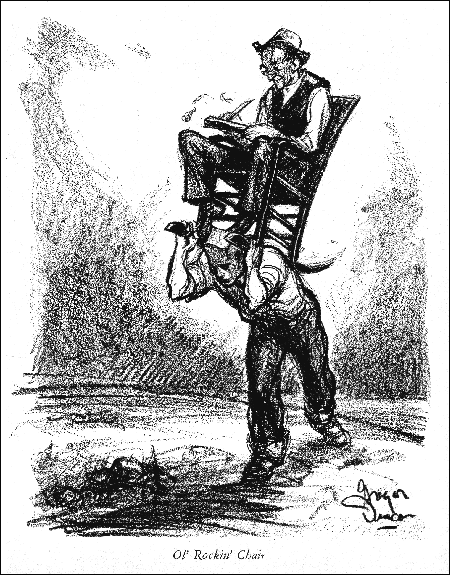
After being passed by Congress in April and signed into law by President Roosevelt on 14th August, 1935. William E. Leuchtenburg has argued: "In many respects, the law was an astonishingly inept and conservative piece of legislation. In no other welfare system in the world did the state shirk all responsibility for old-age indigency and insist that funds be taken out of the current earnings of workers. By relying on regressive taxation and withdrawing vast sums to build up reserves, the act did untold economic mischief. The law denied coverage to numerous classes of workers, including those who needed security most: notably farm laborers and domestics. Sickness, in normal times the main cause of joblessness, was disregarded. The act not only failed to set up a national system of unemployment compensation but did not even provide adequate national standard." (70)
Despite its faults the Social Security Act of 1935 was a new landmark in American history. It reversed historic assumptions about the nature of social responsibility, and it established the proposition that the individual had the same social rights as those people living in Europe. Roosevelt defended his decision to make the employee contributions so high: "We put those payroll contributions there so as to give the contributors a legal, moral, and political right to collect their pensions and their unemployment benefits. With those taxes in there, no damn politician can ever scrap my social security program." (71)
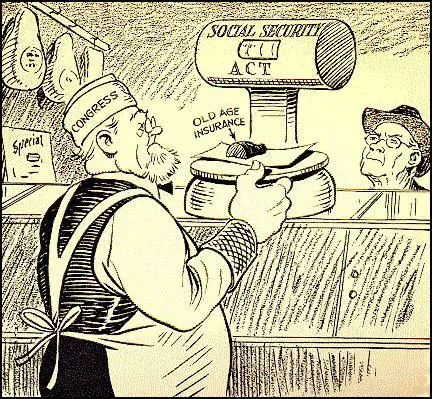
Roosevelt told Anne O'Hare McCormick: "In five years I think we have caught up twenty years. If liberal government continues over another ten years we ought to be contemporary somewhere in the late Nineteen Forties." (72) The British journalist, Henry N. Brailsford, argued that Roosevelt was doing what David Lloyd George had done between 1906 and 1914, but at a quicker tempo. According to William E. Leuchtenburg: "The British reforms, which rested on the conviction that the profit system was compatible with aid to the underdog, had rendered working-class life less precarious and was one of the important reasons that the depression struck Britain less heavily than America." (73)
This reform came under attack from right-wing conservatives. John T. Flynn argued: "Does anyone imagine that $8 a week is security for anyone, particularly since Roosevelt's inflation has cut the value of that in half? But what of the millions of people who through long years of thrift and saving have been providing their own security? What of the millions who have been scratching for years to pay for their life insurance and annuities, putting money in savings banks, commercial banks, buying government and corporation bonds to protect themselves in their old age? What of the millions of teachers, police, firemen, civil employees of states and cities and the government, of the armed services and the army of men and women entitled to retirement funds from private corporations railroads, industrial and commercial? These thrifty people have seen onehalf of their retirement benefits wiped out by the Roosevelt inflation that has cut the purchasing power of the dollar in two. Roosevelt struck the most terrible blow at the security of the masses of the people while posing as the generous donor of security for all." (74)
Francis Townsend claimed that Roosevelt's social security legislation was completely inadequate and in 1936 joined with Father Edward Coughlin and Gerald L. K. Smith to form the National Union of Social Justice. They selected William Lepke as their presidential candidate. The 1936 Presidential Election was one of the greatest election victories in American history. Roosevelt won by 27,751,612 votes to 16,681,913 and carried the electoral college 523 to 8. He won every state but Maine and Vermont. Lepke won only 882,479 votes. (75)
Federal Writers Project
The Works Projects Administration (WPA) was established by Franklin D. Roosevelt as part of the New Deal attempt to combat the Depression. This included the The Federal Writers Project to provide employment for historians, teachers, writers, librarians, and other white-collar workers. The project was directed by Henry Alsberg, a former journalist and theatre director. Originally, the purpose of the project was to produce a series of sectional guide books under the name American Guides, focusing on the scenic, historical, cultural, and economic resources of the United States. Over the next couple of years the project was responsible for about a thousand publications, including fifty-one state and territorial guides, thirty city guides, and twenty regional guides. (76)
Writers involved in the project included Richard Wright, Claude McKay, John Steinbeck, Ralph Ellison, Studs Terkel, Zora Neale Hurston, Nelson Algren, Conrad Aiken, William Attaway, Saul Bellow, Max Bodenheim, John Cheever, Vardis Fisher, Fountain Hughes, Weldon Kees, Kenneth Patchen, May Swenson, Jim Thompson, Frank Yerby, Margaret Walker, Dorothy West and Anzia Yezierska.
William E. Leuchtenburg, the author of The FDR Years: On Roosevelt and His Legacy (1995): "Project workers transcribed chain gang blues songs, recovered folklore that would otherwise have been lost... In Chicago WPA workers translated half a century of foreign language newspapers, a project requiring seventy-seven reels of microfilm... When the magazine Story conducted a contest for the best contribution by a Project employee, the prize was won by an unpublished twenty-nine-year-old who had been working on the essay on the Negro for the Illinois project. With the prize money for his tales, subsequently published as Uncle Tom's Children, Richard Wright gained the time to write his remarkable first novel, Native Son." (77)
The outpouring of literature under the sponsorship of the Federal Writers' Project was "one of the most remarkable phenomena of the era of crisis" wrote the critic Alfred Kazin in his book, On Native Grounds: An Interpretation of Modern American Prose Literature (1942): "Whatever form this literature took... it testified to an extraordinary national self-scrutinizing... Never before did a nation seem so hungry for news of itself." (78)
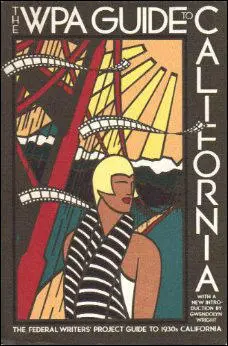
One of the most impressive projects was the Slave Narrative Collection, a set of interviews which led to slave narratives based on the experiences of former slaves, with the work culminating in over 2,300 first-person accounts of slavery and 500 black-and-white photographs of former slaves. This was organised as a state-level branches of the Federal Writers' Projects in seventeen states, working largely separately from each other. (79)
On 26th May, 1938, the United States House of Representatives authorized the formation of the Special House Committee on Un-American Activities. The first chairman of the Un-American Activities Committee (HUAC) was Martin Dies. The original intention of the HUCA was to investigate both left-wing and right wing political groups. However it was soon clear that his main target was New Deal initiatives such as the Federal Writers' Project. John Parnell Thomas, a member of the HUCA, commented that on the basis of "startling evidence" that the project was "a hotbed for Communists". (80)
Dies pointed out in his book, The Trojan Horse in America (1940): "Stalin could not have done better by his American friends and agents. Relief projects swarmed with Communists - Communists who were not only recipients of needed relief but who were entrusted by New Deal officials with high administrative positions in the projects. In one Federal Writers' Project in New York, one third of the writers were members of the Communist Party. This was proven by their own signatures. Many witnesses have testified that it was necessary for W.P.A. workers to join the Workers Alliance - high-pressure lobby run by the Communist Party - in order to get or retain their jobs.... Several hundred Communists held advisory or administrative positions in the W.P.A. projects." (81)
Federal Theatre Project
Franklin D. Roosevelt also established Federal Theatre Project (FTP). To direct the project, Harry Hopkins, named Hallie Flanagan, the head of Vassar's Experimental Theatre. Over a thousand theatre productions took place in twenty-two different states. Many of these were given free in schools and community centres. Other outstanding theatre people served as regional directors, including Charles Coburn and Hiram Motherwell. (82)
Although performers were only paid $22.73 a week, the FTP employed some of America's most talented artists. This included Arthur Miller, who was unemployed after graduating from the University of Michigan. He explained in his autobiography, Timebends - A Life (1987): "To join the WPA Theatre Project it was necessary to get on the welfare rolls first, in effect to be homeless and all but penniless... and conniving to get myself a twenty-three-dollar-a-week job." (83)
In 1934 Orson Welles directed Macbeth for the Negro People's Theatre, as part of the Federal Theatre Project. He also worked with John Houseman in the production of The Cradle Will Rock, a musical by Marc Blitzstein. Houseman argued that Blitzstein, described as "a play with music (while others, at various times, called it an opera, a labour opera, a social cartoon, a marching song and a propagandistic tour de force)". He wrote the play in only five weeks. (84)

The original production with Howard da Silva and Will Geer, was banned for political reasons. It eventually was performed at the Mercury Theatre (108 performances). Welles later recalled: "Marc Blitzstein was almost a saint. He was so totally and serenely convinced of the Eden which was waiting for us all the other side of the Revolution that there was no way of talking politics to him.... When he came into the room the lights got brighter. He was a an engine, a rocket, directed in one direction which was his opera - which he almost believed had only to be performed to start the Revolution." (85)
Elmer Rice was placed in charge of the Federal Theatre Project in New York City. In 1936 alone, the FTP employed 5,385 people in the city. Over a three year period over 12 million people attended performances in the city. One of Rice's innovations was the Living Newspaper (plays which were essentially theatrical documentaries). The first of these plays, Ethiopia, which dealt with Italy's invasion of the country, was banned by Harry Hopkins. (86)
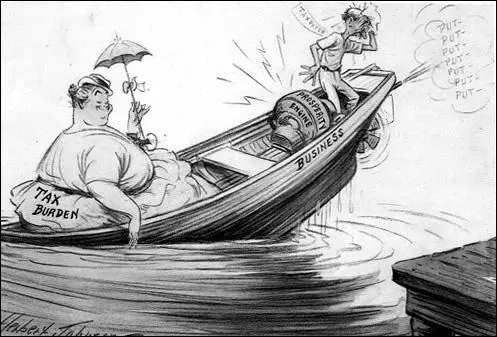
Herbert Johnson, Saturday Evening Post (1935)
One play, It Can't Happen Here, by Sinclair Lewis, in 1936, was produced simultaneously in 22 cities. The Lost Colony (1937) by Paul Green, was an outdoor historical pageant that was performed in a Works Projects Administration built theatre on Roanoake Island. However, several plays were censored as it was believed they were too political. Harold Clurman defended the Federal Theatre Project because he believed it was "the most truly experimental effort ever undertaken in the American theatre." (87)
J. Parnell Thomas, a member of the Un-American Activities Committee (HUAC), described the Federal Theatre Project as being "infested by radicals from top to bottom" and on 26th July, 1938, called for Hallie Flanagan to answer questions before the committee. Flanagan immediately went on the attack arguing that: "Some of the statements reported to have been made by him (Parnell Thomas) are obviously absurd... of course no one need first join or be a member of any organization in order to obtain employment in a theatre project." She also pointed out that only ten per cent of the plays presented by the Federal Theatre dealt with social and political problems. (88)
Sallie Saunders, appeared before the HUAC and condemned the Federal Theatre because it had performed "pro-union plays, plays referring to Negro discrimination, and anti-Fascist plays." Saunders also complained that the project encouraged racial integration and that while working for the FTP she had been "telephoned by a Negro for a date". Hazel Huffman, a former employee of the Works Projects Administration (WPA), claimed that Hallie Flanagan was a person who "was known as far back as 1927 for her communistic sympathy, if not membership" and pointed out that 147 pages of her book, Shifting Scenes of the European Theatre, was devoted to "eulogizing the Russian theater." (89)
Hallie Flanagan eventually appeared before the HUAC. She later recalled: "The room itself, a high-walled chamber with great chandeliers, was lined with exhibits of material from the Federal Theatre and the Writers' Project; but all I could see for a moment were the faces of thousands of Federal Theatre people; clowns in the circus ... telephone girls at the switchboards... actors in grubby rehearsal rooms... acrobats limbering up their routines... costume women busy making cheap stuff look expensive... musicians composing scores to bring out the best in our often oddly assembled orchestras... playwrights working on scripts with the skills of our actors in mind... carpenters, prop men, ushers. These were the people on trial that morning. I was sworn in as a witness by Chairman Dies, a rangy Texan with a cowboy drawl and a big black cigar. I wanted to talk about Federal Theatre, but the Committee apparently did not... Here was a Committee which for months had been actually trying a case against Federal Theatre, trying it behind closed doors, and giving one side only to the press. Out of a project employing thousands of people from coast to coast, the Committee had chosen arbitrarily to hear ten witnesses, all from New York City, and had refused arbitrarily to hear literally hundreds of others, on and off the project, who had asked to testify." (91)
J. Parnell Thomas objected to the radical message in some of these plays. Thomas claimed that: "Practically every play presented under the auspices of the Project is sheer propaganda for Communism or the New Deal." Martin Dies, the chairman of the Un-American Activities Committee, called for the resignations of Harold Ickes, Harry Hopkins and Frances Perkins, as the three had "associates who were Socialists, Communists, and crackpots." (92)
Franklin D. Roosevelt refused to sack these three members of his government but Congress bring the Federal Theatre Project to an end and allowed the other projects to continue only if they found local sponsors who would bear 25 per cent of the cost. During its four years existence the FTP launched or established the careers of such artists as Orson Welles, John Houseman, Will Geer, Arthur Miller, Paul Green, Marc Blitzstein, Canada Lee and Elmer Rice. (93)
Elmer Rice later wrote: "Nationally, the Theatre Project's record was extraordinary. At one time forty-two separate units were in operation in twenty states, with a total of nearly thirteen thousand employees... In its first three years the Theatre Project had produced more than nine hundred different plays, for a total of nearly 55,000 performances, many of them free, none charging more than a dollar. The attendances figures exceeded 26,000,000... In the project's fourth year, Congress killed it... Its demise was perhaps the most tragic occurrence in the cultural history of the United States. Had funds been provided for continuance, upon an artistic basis divorced from unemployment relief, of those units that had clearly demonstrated their worth, the foundation would have been laid for a nationwide theatrical structure that would have brought enlightenment and enjoyment to millions, and stimulation to artistic creation. The cost, compared to the billions expended annually upon weapons of destruction, would have been infinitesimal." (94)
Primary Sources
(1) Herbert Hoover, speech in New York (October, 1932)
The proposals of our opponents will endanger or destroy our system. I especially emphasize that promise to promote "employment for all surplus labour at all times." At first I could not believe that anyone would be so cruel as to hold out hope so absolutely impossible of realization to these 10,000,000 who are unemployed. And I protest against such frivolous promises being held out to a suffering people.
If it were possible to give this employment to 10,000,000 people by the Government, it would cost upwards of $9,000,000,000 a year. It would pull down the employment of those who are still at work by the high taxes and the demoralization of credit upon which their employment is dependent. It would mean the growth of a fearful bureaucracy which, once established, could never be dislodged.
(2) Franklin D. Roosevelt, speech in Boston (October, 1932)
We have two problems: first, to meet the immediate distress; second, to build up on a basis of permanent employment.
As to immediate relief, the first principle is that this nation, this national government, if you like, owes a positive duty that no citizen shall be permitted to starve.
In addition to providing emergency relief, the Federal Government should and must provide temporary work wherever that is possible. You and I know that in the national forests, on flood prevention, and on the development of waterway projects that have already been authorized and planned but not yet executed, tens of thousands, and even hundreds of thousands of our unemployed citizens can be given at least temporary employment.
(3) Franklin D. Roosevelt, radio broadcast, Fireside Chat (7th May, 1933)
The legislation which has been passed or in the process of enactment can properly be considered as part of a well-grounded plan.
First, we are giving opportunity of employment to one-quarter of a million of the unemployed, especially the young men who have dependents, to go into the forestry and flood prevention work. This is a big task because it means feeding, clothing and caring for nearly twice as many men as we have in the regular army itself. In creating this civilian conservation corps we are killing two birds with one stone. We are clearly enhancing the value of our natural resources and second, we are relieving an appreciable amount of actual distress. This great group of men have entered upon their work on a purely voluntary basis, no military training is involved and we are conserving not only our natural resources but our human resources. One of the great values to this work is the fact that it is direct and requires the intervention of very little machinery. Second, I have requested the Congress and have secured action upon a proposal to put the great properties owned by our Government at Muscle Shoals to work after long years of wasteful inaction, and with this a broad plan for the improvement of a vast area in the Tennessee Valley. It will add to the comfort and happiness of hundreds of thousands of people and the incident benefits will reach the entire nation.
Next, the Congress is about to pass legislation that will greatly ease the mortgage distress among the farmers and the home owners of the nation, by providing for the easing of the burden of debt now bearing so heavily upon millions of our people.
Our next step in seeking immediate relief is a grant of half a billion dollars to help the states, counties and municipalities in their duty to care for those who need direct and Immediate relief.
The Congress also passed legislation authorizing the sale of beer in such states as desired. This has already resulted in considerable reemployment and, incidentally, has provided much needed tax revenue.
We are planning to ask the Congress for legislation to enable the Government to undertake public works, thus stimulating directly and indirectly the employment of many others in well-considered projects.
Further legislation has been taken up which goes much more fundamentally into our economic problems. The Farm Relief Bill seeks by the use of several methods, alone or together, to bring about an increased return to farmers for their major farm products, seeking at the same time to prevent in the days to come disastrous over-production which so often in the past has kept farm commodity prices far below a reasonable return. This measure provides wide powers for emergencies. The extent of its use will depend entirely upon what the future has in store.
Well-considered and conservative measures will likewise be proposed which will attempt to give to the industrial workers of the country a more fair wage return, prevent cut-throat competition and unduly long hours for labor, and at the same time to encourage each industry to prevent over-production.
(4) Emanuel Celler, wrote about President Franklin D. Roosevelt and the New Deal in his autobiography, You Never Leave Brooklyn (1953)
The first days of the Roosevelt Administration charged the air with the snap and the zigzag of electricity. I felt it. We all felt it. It seemed as it you could hold out your hand and close it over the piece of excitement you had ripped away. It was the return of hope. The mind was elastic and capable of crowding idea into idea. New faces came to Washington - young faces of bright lads who could talk. It was contagious. We started to talk in the cloak rooms; we started to talk in committees. The shining new faces called on us and talked.
In March of 1933 we had witnessed a revolution - a revolution in manner, in mores, in the definition of government. What before had been black or white sprang alive with color. The messages to Congress, the legislation; even the reports on the legislation took on the briskness of authority. I have asked myself often, "Did one man do this? If one did this, what manner of man was he?" I don't know. I think nobody does. Since those days I have read every bit of writing on Roosevelt: Perkins, Sherwood, Churchill, Eleanor Roosevelt, Flynn, Gunther. Out of these cascades of words no definite or sharp outline arises. Whenever I visited Roosevelt on official business, I found a man adroit, voluble, assured, and smiling. I was never quite sure he was interested in the purpose of my visit; we spent so little time on it.
Mostly he talked. He talked with seeming frankness, and when I left, I found that he had committed himself to no point of view. At the end of each visit I realized that I had been hypnotized. His humor was broad, his manner friendly without condescension. Of wit there was little; -of philosophy, none. What did he possess? Intuition, yes. Inspiration, yes. Love of adventure, the curiosity of the experimental. None of these give the answer. None of these give the key. I believe his magic lay in one facet of his personality. He could say and he did say, "Let's try it." He knew how to take the risk. No other man in public life I knew could so readily take the challenge of the new.
(5) Charlie Chaplin, My Autobiography (1964)
The lugubrious Hoover sat and sulked, because his disastrous economic sophistry of allocating money at the top in the belief that it would percolate down to the common people had failed. And amidst all this tragedy he ranted in the election campaign that if Franklin Roosevelt got into office the very foundations of the American system - not an infallible system at that moment - would be imperilled.
However, Franklin D. Roosevelt did get into office, and the country was not imperilled. His 'Forgotten Man' speech lifted American politics out of its cynical drowse and established the most inspiring era in American history. I heard the speech over the radio at Sam Goldwyn's beach-house. "The only thing we have to fear is fear itself" came over the air like a ray of sunlight. But I was sceptical, as were most of us. "Too good to be true," I said.
No sooner had Roosevelt taken office than he began to fit actions to his words, ordering a ten-day bank holiday to stop the banks from collapsing. That was a moment when America was at its best. Shops and stores of all kinds continued to do business on credit, even the cinemas sold tickets on credit, and for ten days, with Roosevelt and his so-called brains trust formulated the New Deal, the people acted magnificently.
Legislation was ordered for every kind of emergency: re-establishing farm credit to stop the wholesale robbery of foreclosures, financing big public projects, establishing the National Recovery Act, raising the minimum wage, spreading out jobs by shortening working hours, and encouraging the organization of labour unions. This was going to far; this was socialism, the opposition shouted. whether it was or not, it saved capitalism from complete collapse. It also inaugurated some of the finest reforms in the history of the United States. It was inspiring to see how quickly the American citizen reacted to constructive government.
(6) Calvin Benham Baldwin, was assistant to Henry Wallace, Secretary of Agriculture, in Franklin D. Roosevelt's administration in 1933.
The New Deal was an uneasy coalition. Fights developed very early between two factions: one, representing the big farmers, and the other, the little farmers. The Agricultural Adjustment Administration (AAA) came into being shortly after I got to Washington. Its purpose was to increase farm prices, which were pitifully low. All the farmers were in trouble, even the big ones.
Hog prices had just gone to hell. They were four, five cents a pound? The farmers were starving to death. It was decided to slaughter piggy sows (a pregnant pig). The AAA decided to pay the farmers to kill them and the little pigs. Lot of them went into fertilizer. Then a great cry went up from the press, particularly the Chicago Tribune, about Henry Wallace slaughtering these little pigs. You'd think they were precious babies.
You had a similar situation on cotton. Prices were down to four cents a pound and the cost of producing was probably ten. So a program was initiated to plow up cotton. A third of the crop, if I remember. Cotton prices went up to ten cents, maybe eleven.
(7) Frances Perkins was secretary for labour in Franklin D. Roosevelt's first cabinet. She wrote about this period in her book, The Roosevelt I Knew (1946)
In one of my conversations with the President in March 1933, he brought up the idea that became the Civilian Conservation Corps. Roosevelt loved trees and hated to see them cut and not replaced. It was natural for him to wish to put large numbers of the unemployed to repairing such devastation. His enthusiasm for this project, which was really all his own, led him to some exaggeration of what could be accomplished. He saw it big. He thought any man or boy would rejoice to leave the city and work in the woods.
It was characteristic of him that he conceived the project, boldly rushed it through, and happily left it to others to worry about the details. And there were some difficult details. The attitude of the trade unions had to be considered. They were disturbed about this program, which they feared would put all workers under a "dollar a day" regimentation merely because they were unemployed.
(8) Popular joke in the United States in the 1934 about different political theories.
Socialism: If you own two cows you give one to your neighbour.
Communism: You give both cows to the government and the government gives you back some of the milk.
Fascism: You keep the cows but give the milk to the government, which sells some of it back to you.
New Dealism: You shoot both cows and milk the government.
(9) John T. Flynn, The Roosevelt Myth (1944)
Roosevelt did not restore our economic system. He did not construct a new one. He substituted an old one which lives upon permanent crises and an armament economy. And he did this not by a process of orderly architecture and building, but by a succession of blunders, moving one step at a time, in flight from one problem to another, until we are now arrived at that kind of statesupported economic system that will continue to devour a little at a time the private system until it disappears altogether.
He did not restore our political system to its full strength. One may like the shape into which he battered it, but it cannot be called a repair job. He changed our political system with two weapons blankcheck congressional appropriations and blankcheck congressional legislation. In 1933, Congress abdicated much of its power when it put billions into his hands by a blanket appropriation to be spent at his sweet will and when it passed general laws, leaving it to him, through great government bureaus of his appointment, to fill in the details of legislation.
These two baleful mistakes gave him a power which he used ruthlessly. He used it to break down the power of Congress and concentrate it in the hands of the executive. The end of these two betrayals the smashing of our economic system and the twisting of our political system can only be the Planned Economic State, which, either in the form of Communism or Fascism, dominates the entire continent of Europe today. The capitalist system cannot live under these conditions. The capitalist system cannot survive a Planned Economy. Such an economy can be managed only by a dictatorial government capable of enforcing the directives it issues. The only result of our present system unless we reverse the drift must be the gradual extension of the fascist sector and the gradual disappearance of the system of free enterprise under a free representative government.
There are men who honestly defend this transformation. They at least are honest. They believe in the Planned Economy. They believe in the highly centralized government operated by a powerful executive. They do not say Roosevelt saved our system. They say he has given us a new one. That is logical. But no one can praise Roosevelt for doing this and then insist that he restored our traditional political and economic systems to their former vitality.
(10) Miriam Moskowitz, Phantom Spies, Phantom Justice (2010)
The New Deal programs were designed to be economic investments to relieve the suffering and to put people back to work, to calm the mounting fear and to rout the sense of hopelessness, unrest and hardship caused by the Depression. They were unprecedented and they permanently altered the economic, social and governmental landscapes. They included Social Security, Unemployment Insurance, price supports, the building of an interstate highway system and rural electrification through the Tennessee Valley Authority. The programs also instituted government regulation of banking and the stock market to protect bank depositors against bank failures (which occurred frequently after the stock market crash of 1929) and investors from stock market failures, then a common Wall Street nightmare. In addition, the New Deal created the National Housing Act under which the Federal Housing Administration offered home loans and mortgage insurance to benefit mostly low- and middle-income home buyers.The massive spending stimulated recovery by funneling money into the economy as payments for material, equipment and labor. It thus increased the national purchasing power until the economy could expand and private industry could recover enough to begin hiring again. At the same time, the WPA programs took care of the needs of some of the country's infrastructure, including the construction of public buildings, bridges, roadways and airports, as well as conservation work in the national parks and forests. It also conducted an education program through the National Youth Administration, training young people and helping them find work. More critically, the New Deal Farm Security Administration provided emergency loans to farmers to rescue them from impending bankruptcy.
Not least among the programs was the Federal Arts Project; it gave dignified and creative work to scores of unemployed theater people, artists, writers, teachers and musicians and it brought the arts to millions of Americans.
For example, the Music Project's many symphony orchestras gave about four thousand performances a month before 150 million people, more than half of whom had never heard a live orchestra before. Thousands more learned to play or sing at its many teaching centers.
The Theater Project's companies played to over 25 million people, most of whom had never seen a stage play before. Some of their productions were highly innovative. Among those who got their start here were Orson Welles, John Houseman, John Huston and Norman Lloyd.
The Art Project's artists produced nearly a million works of visual art which were exhibited and used by schools, courthouses, hospitals, libraries, post offices and other public buildings. And each month 60,000 people came to the free art classes offered by the Art Project. Some of the artists and photographers who emerged from this program included Franz Kline, Willem de Kooning, BenShahn, Hugo Gellert, Miguel Coverrubias, Al Hirschfield, Gordon Parks, Dorothea Lange and Arthur Rothstein. Much of the art produced under the aegis of the Art Project provided a vivid record, otherwise unobtainable, of life during the Depression.
The Writers' Project employed workers of literary competence and included many teachers who could not find teaching jobs. Some of these writers trekked the countryside, discovering untapped fountains of folklore and history, wrote about them and provided invaluable data for later researchers of Americana. Writers who came out of this program included Conrad Aiken, Saul Bellow, Studs Terkel, Richard Wright, Nelson Algren, Ralph Ellison, John Cheever and Malcolm Cowley.
The Federal Arts Projects collectively became one of the most culturally productive and creative periods in American history. Nevertheless, it faced considerable opposition in Congress almost from the first days of its creation. The opposition had two roots: the idea that work relief was not something the government should be involved in and the accusation that the WPA projects constituted a network for militant trade unionists and communists. The House Investigative Committee in 1939 began a campaign of intimidation by questioning Federal Arts Project employees regarding their union and political activities, hoping to rouse support for eliminating the programs. The Senate joined in the harassment. As a result, in 1939 the WPA appropriations were cut and the Federal Arts Project died. The WPA itself went out of business officially in 1943.
The New Deal was, in almost every aspect, revolutionary in scope and it was fought bitterly by America's right wing. (What remains of it today is still under attack: witness the recent drive to scuttle Social Security - as well as Medicare passed in the Johnson era.)
Student Activities
Economic Prosperity in the United States: 1919-1929 (Answer Commentary)
Women in the United States in the 1920s (Answer Commentary)
Volstead Act and Prohibition (Answer Commentary)
The Ku Klux Klan (Answer Commentary)
Classroom Activities by Subject
